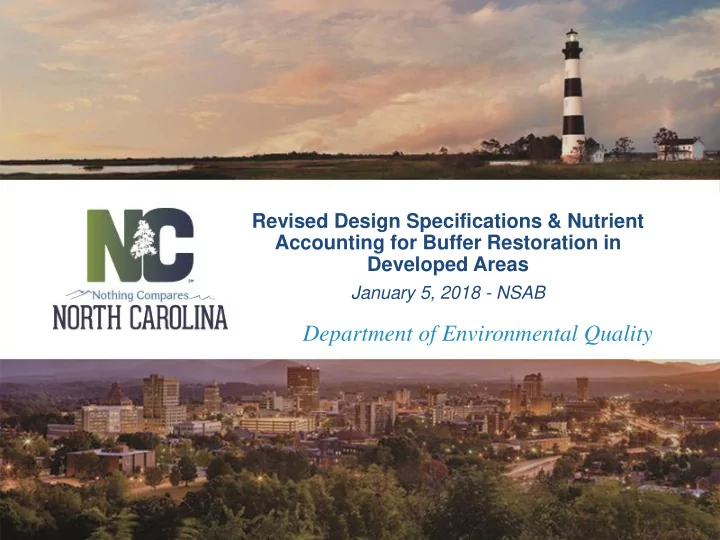

Revised Design Specifications & Nutrient Accounting for Buffer Restoration in Developed Areas January 5, 2018 - NSAB Department of Environmental Quality
Background for Nutrient Reduction Practice • Existing Buffer Restoration crediting is based on rural conditions • Assumes literature-based values for areas of agricultural drainage and nutrient loads from ag land covers • Needed a nutrient crediting method for buffer restoration in developed (non-ag) settings Department of Environmental Quality 2
Brief History • Initial practice development by UNRBA and Cardno Spring 2016 • Presentation to NSAB December 2016 • Lots of comments, reviewed method against data, extensive revision through 2017 • Review/comment by UNRBA, 401 Unit, DMS • Incorporate comments and revise for NSAB Department of Environmental Quality 3
Desired Practice Elements • Variable buffer widths (min 20’ – max 200’) • Calculation based on site-specific conditions • Diffuse concentrated flows for more credit • Time-limited implementations (requires no conservation easement) • Minimized surveying and reporting requirements • Incorporate existing forest and utility easements • Simple credit calculation method • Otherwise: use similar conditions and requirements as Alt. Buffer Mitigation Rule (.0295) Department of Environmental Quality 4
Jan 2018 Draft: Practice Conditions • Use in areas of >50% developed • Restoration and/or enhancement • All stream flow types and conditions •Min 20’ width, max 200’ width • Allow the use level spreaders to diffuse more flows • Buffer use limitations recommended by CWP Department of Environmental Quality 5
Jan 2018 Draft: Practice Requirements • Buffer Improvement Plan: • Map with delineated area of land covers • Implementation schedule, plant establishment, grading, soil improvement / erosion control, fertilization, weed / pest control • O & M and Monitoring plan • 260 stems/ac at 5 years, 4+ hardwood/shrub species • Annual documentation first 5 years, every 5 years after for time-limited projects • Level spreaders designed to 65ft/cfs Department of Environmental Quality 6
Jan 2018 Draft: Credit Calculation • Nutrient reduction: land conversion + treatment of runoff through buffer • Reduction from land conversion and nutrient loads in upslope runoff (developed) SNAP v4 • Nutrient loads from upslope ag fixed loading • Buffer treatment percent reduction • Percent reduction (N & P) based on Nitrogen Loss Estimation Worksheet • Credit modifications for credit release schedule, enhancement, low survivorship Department of Environmental Quality 7
Jan 2018 Percent Reductions Average Buffer Percent Width Phosphorus from Top-of-Bank Percent Nitrogen Reduction (feet) Reduction 20% 20% 20-29 25% 25% 30-49 30% 30% 50-74 32% 32% 75-99 35% 35% 100-199 200+ 40% 40% Department of Environmental Quality 8
Jan 2018 Credit Release Schedule Reporting Period Credit Release Modifier Initial implementation 50% of full credit 1 year after implementation 60% of full credit 2 years after implementation 70% of full credit 3 years after implementation 80% of full credit 4 years after implementation 90% of full credit 5 years after implementation 100% of full credit >5 years after implementation 100% of full credit Department of Environmental Quality 9
Jan 2018 Agricultural Land Use Loading Rates Agricultural Land N loading rate P loading rate Cover (lb/ac/yr) (lb/ac/yr) Crops 8 2 Pasture 5 1 • Only use to calculate load where ag land use is <50% of area • Use SNAP v4 for all other calculations of nutrient load in runoff Department of Environmental Quality 10
Changes from Dec 2016 Draft • Sticks to conditions and requirements of .0295 as much as possible: • Vegetative success criteria • Stream types and site conditions • Improvement plan requirements • Mods from .0295 are for desired elements and to ensure accountability • 5 year reporting for time-limited projects, no easement • Credit release schedule and low survivorship discount • Veg survey explicit, but simpler than standard UMBIs • Buffer use limitations Department of Environmental Quality 11
Changes from Dec 2016 Draft • Same crediting for all stream flows/conditions • Same reduction through buffer for N and P • Simplified buffer use limitations • Predominantly developed drainage area • Inclusion of minor areas of agriculture • Enhancement may be 100% of project • Sewer easements in Zone 2 OK • Simplified differences between permanent and time-limited • Percent reduction based on blocks of buffer width • Options for incremental percent reduction if not restoring adjacent to the streambank Department of Environmental Quality 12
Unchanged from Dec 2016 Draft • Sites with all kinds of stream conditions/flows •Min width 20’, max width 200’ • Level spreaders to diffuse flows, MDC with 65ft/cfs • Requires diffusion of roof drains, small stormwater • No additional stormwater flows • Permanent and time-limited options • Land conversion calculation separate from buffer treatment calculation • Percent reduction based on NLEW Department of Environmental Quality 13
QUESTIONS? Department of Environmental Quality 15
Recommend
More recommend